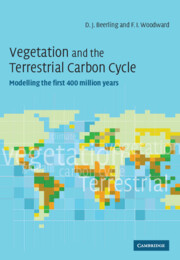Book contents
- Frontmatter
- Contents
- Preface
- Acknowledgements
- 1 Introduction
- 2 Investigating the past from the present
- 3 Climate and terrestrial vegetation
- 4 Climate and terrestrial vegetation of the present
- 5 The late Carboniferous
- 6 The Jurassic
- 7 The Cretaceous
- 8 The Eocene
- 9 The Quaternary
- 10 Climate and terrestrial vegetation in the future
- 11 Endview
- References
- Index
4 - Climate and terrestrial vegetation of the present
Published online by Cambridge University Press: 09 August 2009
- Frontmatter
- Contents
- Preface
- Acknowledgements
- 1 Introduction
- 2 Investigating the past from the present
- 3 Climate and terrestrial vegetation
- 4 Climate and terrestrial vegetation of the present
- 5 The late Carboniferous
- 6 The Jurassic
- 7 The Cretaceous
- 8 The Eocene
- 9 The Quaternary
- 10 Climate and terrestrial vegetation in the future
- 11 Endview
- References
- Index
Summary
Introduction
Climate drives particular vegetation processes from the short term, such as photosynthesis from minute to minute, to the long term, such as the gradual accumulation of plant litter in the soil, over periods up to millennia. Terrestrial vegetation can also influence climate though variations in its structural characteristics, such as surface reflectivity and roughness length, and functional characteristics, such as evapotranspiration (Bonan et al., 1992; Lean & Rowntree, 1993; Betts et al., 1997). These features are not considered here as this intimate coupling of vegetation and climate is not yet a standard feature of the General Circulation Models (GCMs) which are used throughout this book for predicting past and present climates.
In order to appreciate the predictions of terrestrial vegetation activity and climate it is necessary to provide a general introduction to the two areas of modelling. Aspects of vegetation modelling have already been covered in Chapters 2 and 3. This chapter will provide a fuller description of the vegetation model which is used in all of the simulations in this book. A general introduction to GCMs will also be provided, although details of these complex models must be found elsewhere (e.g. Washington & Parkinson, 1986; Trenberth, 1992; McGuffie & Henderson-Sellers, 1997).
- Type
- Chapter
- Information
- Vegetation and the Terrestrial Carbon CycleThe First 400 Million Years, pp. 53 - 99Publisher: Cambridge University PressPrint publication year: 2001



